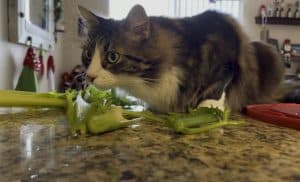Note: We may earn a commission from helpful, relevant links in our content. No cost to you. See our privacy policy.
Catching your cat rolling around euphorically in a bed of green leaves can be as entertaining for you as it is blissful for them. But as they twist and turn with eyes half-closed in catnip-induced delight, have you ever wondered what’s behind this peculiar pleasure fest?
By the end of this read, you’ll have the scoop on your kitty’s catnip craze—enough knowledge to become the ultimate catnip companion they never knew they needed.
Key takeaways:
- Catnip euphoria: Nepetalactone in catnip triggers a joyous response in about 50-70% of cats, mimicking happy pheromones and sparking playful to wild behaviors.
- Use with care: Provide catnip in moderation ensuring it remains a special treat, rotate catnip toys to prevent desensitization, and watch for any negative reactions.
- Not just for play: Employ catnip for stress relief during anxious times, as a training aid for positive behaviors, and in toys or sprays for added feline stimulation.
What Exactly Is Catnip?
Ever wondered what’s so special about that green, leafy substance that turns your kitty into a ball of hyper-enthusiastic fur? Say hello to catnip: a perennial herb that’s part of the mint family, known scientifically as Nepeta cataria.
This fascinating plant is more than just your average shrub; it’s a feline’s delight, native to Europe and Asia but has since made its way into gardens and homes worldwide.
Its minty relatives hint at its fresh, zesty scent, which is just the tip of the iceberg when it comes to catnip’s appeal. Catnip is not only feline-friendly but also a pleasant addition to your herb garden. It’s often found in plant nurseries, but can also grow wildly in meadows, which speaks volumes about its unassuming nature and robustness.
Why Does My Cat Go Crazy for Catnip?
A little sprinkle of those leaves can make the calmest kitty tumble into a frenzy of joy.
And it’s all thanks to a little compound called nepetalactone. When your pawed pal sniffs this stuff, it binds to their sensory neurons, much like keys to a lock. This compound mimics the effects of feline “happy” pheromones and sets off a series of responses that range from rolling and purring to zooming around the room like a furry race car.
This botanical magic works through the cat’s olfactory system, which is why just a whiff can send them to cloud nine. But why the wild behaviors? It’s thought that nepetalactone triggers the neural pathways associated with hunting instincts and mating behaviors—although it’s all fun and games with no real prey or partners at hand.
Can All Cats Feel the Effects of Catnip?
Here’s where it gets interesting: not all felines are aboard the catnip train. Sensitivity to catnip is actually genetic, which means some cats might give that nip a sniff and strut away with utter indifference.
Studies suggest that about 50 to 70% of cats exhibit a noticeable reaction to catnip. Kittens and senior cats are less likely to be responsive, and there’s a hereditary disposition, meaning if your cat’s parents were catnip aficionados, the odds are higher your kitty will be too.
While the majority may enjoy the euphoria-inducing plant, those not affected by catnip needn’t miss out on the fun. There are alternatives like silver vine or valerian root that can also provide a similar sensory experience for the nip-immune kitty crowd.
So, next time you sprinkle that little bit of green onto your cat’s favorite toy, remember, you’ve just unlocked a door to a world of feline bliss—or you’ve just discovered your furry friend is part of an exclusive group unfazed by catnip’s charm. Rest assured, the catnip conundrum isn’t a deal-breaker for fun times with your cat. There’s a whole world of delightful and engaging cat antics to be explored, with or without it!
Is Catnip Safe for My Cat?
You’ve probably seen cats go wild over catnip, rolling around in delight, purring, and even drooling. But as a responsible pet owner, you might wonder if catnip is like opening a kitty version of Pandora’s box. Let me put your mind at ease: catnip is generally safe for your feline friend.
Nepeta cataria, the plant that gives us catnip, contains a compound called nepetalactone that’s the main culprit behind your cat’s euphoria. Most cats respond to catnip by becoming more playful, exhibiting a burst of energy, or chilling out completely. However, just like any treat, moderation is key.
Here’s what you should keep in the back of your mind:
- Non-toxic: Rest assured, catnip is non-toxic to cats.
- Non-addictive: There’s no need to worry about Fluffy getting hooked. Catnip doesn’t have addictive properties.
- Intoxication: Some kitties might experience a kind of ‘intoxication’ that can make them incredibly excited. This is usually harmless.
- Recommended amounts: A sprinkle of dried catnip or a catnip toy is enough to entertain your cat. Less is more here—you don’t want to overwhelm them.
However, a handful of cats might react adversely, showing signs of aggression or just feeling a bit off. Keep an eye out and if you notice anything out of the ordinary, it’s time to ease off the catnip.
As a pro tip, remember to rotate catnip toys and treats to keep them effective—too much exposure can lead to desensitization.
How Can I Use Catnip for My Cat’s Benefit?
While catnip is often associated with playtime, don’t pigeonhole it just yet! It’s a versatile tool that can enhance your cat’s life in other ways too.
- Stress relief: Introduce catnip during potentially stressful situations like vet visits or when moving homes to help calm your cat’s nerves.
- Training tool: Sprinkle a bit of catnip on a scratching post to encourage proper scratching behavior. Paws down, it’s better than your couch!
- Toys: Invest in refillable catnip toys. Some come designed to stimulate your cat’s natural hunting instincts, doubling the fun.
- Sprays: Catnip sprays are great for sprucing up old toys or cat beds, making them irresistible again.
One unique use: Create a “catnip hunt” by hiding small amounts of catnip around the house. This not only enriches your cat’s environment but also triggers their foraging instincts—a double whammy for wellbeing. Not many talk about this, but it’s a golden nugget for flapjack’s physical and mental stimulation!
Does Catnip Have Any Effect on Other Animals or Humans?
Now let’s talk about the house’s other residents. We know dogs are from Mars and cats are from Venus when it comes to catnip. Most dogs aren’t affected by catnip in the way cats are. So, Rover probably won’t show much interest, though a few might roll in it—go figure.
But what about us humans? We belong to a different party altogether—catnip doesn’t give us that buzz. It has been used in herbal remedies for humans, purportedly for its mild sedative effects when consumed as tea. Although it’s not a humans’ recreational delight nor a go-to relaxant like it is for cats, it’s still an interesting herb with its place in the garden.
In conclusion, catnip is a bit of a wonder-plant, bringing joy and enrichment to your cat’s life. Keep it safe by playing it cool with the amounts, and get creative to reap the full benefits. As they say—happy cat, happy life!
Alex, a passionate animal lover, has experience in training and understanding animal behavior. As a proud pet parent to two dogs and three cats, he founded AnimalReport.net to share insights from animal experts and expand his knowledge of the animal kingdom.










